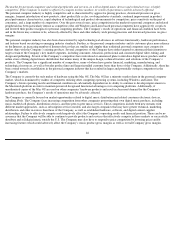Apple 2005 Annual Report Download - page 55
Download and view the complete annual report
Please find page 55 of the 2005 Apple annual report below. You can navigate through the pages in the report by either clicking on the pages listed below, or by using the keyword search tool below to find specific information within the annual report.
remaining commitments per location ranging from $4 million to $46 million. Closure or poor performance of one of these high profile stores
could have a particularly significant negative impact on the Company’s results of operations and financial condition.
Many of the general risks and uncertainties the Company faces could also have an adverse impact on its Retail segment. Also, many factors
unique to retail operations present risks and uncertainties, some of which are beyond the Company’s control, that could adversely affect the
Retail segment’s future results, cause its actual results to differ from those currently expected, and/or have an adverse effect on the Company’s
consolidated results of operations. Potential risks and uncertainties unique to retail operations that could have an adverse impact on the Retail
segment include, among other things, macro-economic factors that have a negative impact on general retail activity; inability to manage costs
associated with store construction and operation; failure to attract new users to the Macintosh platform; inability to sell third-party hardware
and software products at adequate margins; failure to manage relationships with existing retail channel partners; lack of experience in
managing retail operations outside the U.S.; costs associated with unanticipated fluctuations in the value of Apple-branded and third-
party retail
inventory; and inability to obtain quality retail locations at reasonable cost.
Investment in new business strategies and initiatives could disrupt the Company
’s ongoing business and may present risks not originally
contemplated.
The Company has and may in the future invest in new business strategies or engage in acquisitions that complement the Company’s strategic
direction and product roadmap. Such endeavors may involve significant risks and uncertainties, including distraction of management’s
attention away from normal business operations; insufficient revenue generation to offset liabilities assumed and expenses associated with the
strategy; and unidentified issues not discovered in the Company’s due diligence process. Because these new ventures are inherently risky, no
assurance can be given that such strategies and initiatives will be successful and will not materially adversely affect the Company’s business,
operating results or financial condition.
Declines in the sales of the Company
’s professional products, software, accessories, or service and support contracts, or increases in sales of
consumer products, including iPods, may negatively impact the Company’s gross margin and operating margin percentages.
The Company’s professional products, including Power Macintosh and PowerBook systems, software, accessories, and service and support
contracts, generally have higher gross margins than the Company’s consumer products, including iMacs, iBooks, iPods, and content from the
iTunes Music Store. A shift in sales mix away from higher margin professional products towards lower margin consumer products could
adversely affect the Company’s future gross margin and operating margin percentages. The Company’s traditional professional customers may
choose to buy consumer products, specifically the iMac G5 and iBook, instead of professional products. Professional users may choose to buy
the iMac G5 due to its relative price performance, use of the same PowerPC G5 processor used in the Company’s Power Macs, and unique
design featuring a flat panel screen. Potential PowerBook customers may also choose to purchase iBooks instead due to their price performance
and screen size. Additionally, significant future growth in iPod sales without corresponding growth in higher margin product sales could also
reduce gross margin and operating margin percentages.
It is likely that some of the Company’s current and potential
professional, creative, and small business customers, who are most likely to utilize
professional systems,
believe that the relatively slower MHz rating or clock speed of the microprocessors the Company utilizes in its Macintosh
systems compares unfavorably to those utilized by other computer manufacturers and translates to slower overall system performance. These
factors may result in an adverse impact to sales of the Company’s professional products as well as to gross margin and operating margin
percentages.
53
























